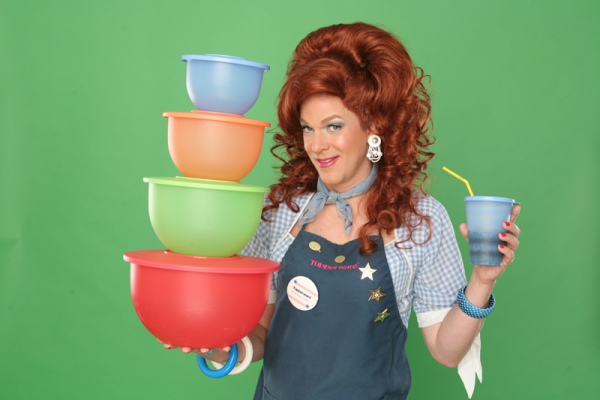Dixie's Tupperware Party

(© Bradford Rogne)
Not since the heyday of Cameron Mackintosh have audience members desperately wanted to grab their checkbooks after a show and buy, buy, buy. So persuasive a saleswoman is Dixie Longate that she makes audiences feel compelled to flip through her catalog to purchase cups that lock in liquids like Jack Daniel's, cupcake holders that can also substitute for Jell-O shot trays, and slick corkscrew removers that make opening wine bottles while driving on the freeway trouble-free.
The drag queen alter ego of writer Kris Andersson, Dixie is a poor ex-convict Alabama mama from a trailer park who does more than sell during her evenings; she pays tribute to women, and her caustic routine is a hoot and a holler. Dixie Longate may not be a real person but she is the real deal. She and other drag personalities like Kay Sedia and Mocha Momma have been selling Tupperware to hip Angelenos for years and rank in the top echelon of Tupperware's sales force. Her one-woman show is an extension of the parties she hosts.
Dixie reminds audiences how American women in the '50s found themselves dismissed by the male-dominated workforce after they had courageously stepped up in World War II to fill the void left by those who had gone off to war. Strong and savvy enough to build weapons and ships during the war, they were later deemed superfluous and sent back to their kitchen prisons, only to find salvation with multi-marketing projects like Tupperware. Dixie uses this bit of history not only to remind audiences of what the downtrodden can accomplish with a bit of ingenuity but also to pay homage to the woman who started the revolution by inventing the Tupperware party, Brownie Wise. Dixie hasn't hitchhiked from Alabama to preach though. Her performance is a running gag of gibes at the audience members, who become a part of the show. She engages with individuals (stripping some down with her vicious tongue), holds raffles for— in her words — free crap, and forces lovely ladies to compete in a stackable bowl contest.
Andersson's creation of Dixie is a marvel. Tall and statuesque with a poofy-red wig that could hide Jimmy Hoffa and enough energy to fuel the western seaboard, his Dixie is a nonstop adrenaline boost. With a thick Alabama accent, she speaks so fast, most of her words come out garbled. When she incoherently instructs a poor volunteer to follow directions, it leads to mass hysteria. Irreverent and more than a little nasty, she sexualizes everything and rips apart political correctness.
Andersson and director Patrick Richwood chose not to ruminate about causes or build a lengthy backstory for Dixie, which is why Dixie’s Tupperware Party works so well. Their goal is to entertain, get their audiences to laugh until they can't breathe, and then sell some plastic.










